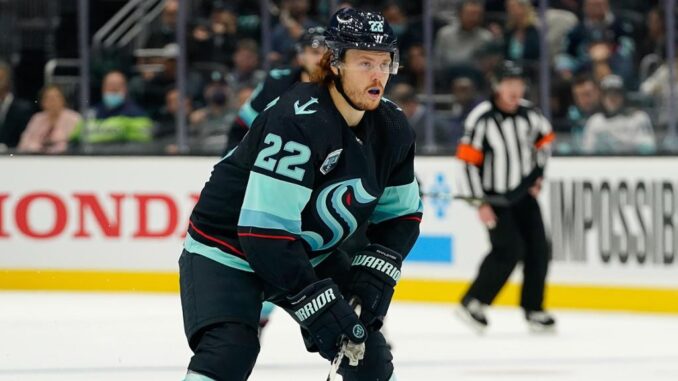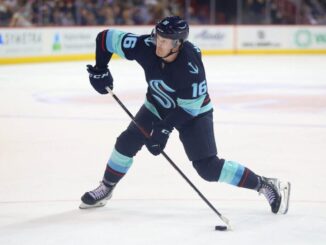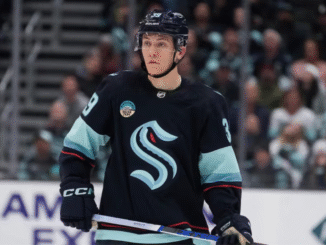
To say that the Seattle Kraken’s inaugural season in the NHL hasn’t gone according to plan is an understatement, as the expansion franchise sits 29th overall in terms of points percentage and look to be as far away from playoff contention as possible. It could be time to start looking past this potentially lost season and towards the future. The roster seems set for considerable turnover, as only 11 regulars are under contract for the 2022-23 season. General manager Ron Francis and his management team appear to have several critical decisions to make, and their choices could significantly influence the franchise’s future trajectory. With that, here are three free agents that the Kraken should prioritize in their offseason plans.
Jared McCann, Forward
2021-22 Stats: 29 GP – 14 G – 7 A – 21 PTS
Of the players needing new contracts, Jared McCann presents the most compelling case for an extension. The former member of the Pittsburgh Penguins leads the Kraken in goals (14) and sits second in points (21), behind only Jordan Eberle.
McCann’s efficient rate of point production (2.13 points per-60 minutes at 5-on-5) places him third on the Kraken, demonstrating he hasn’t just been a fortunate beneficiary of increased ice-time and favorable usage. That’s not to say that McCann’s more frequent appearances on the power play aren’t helping, as he’s on track to eclipse his current career-highs in goals (seven) and points (10) by the end of the year.
Related: 3 Early Trade Candidates For The Seattle Kraken
McCann is technically a restricted free agent (RFA), giving the team control over his deal and retain first rights on matching any offer sheet he might sign. Of course, that’s only if the Kraken fail to sign him before the start of free agency. He’ll turn 26 before the start of next season, meaning that the Kraken aren’t necessarily tying themselves to a declining asset with his next contract, decreasing their level of assumed risk.
What could McCann earn on his next contract? His current deal pays him nearly $3 million a season, and he has done enough to deserve a slight raise ($3.5-4 million?), but I can’t see him commanding much more than that given his RFA status. At any rate, failing to corral your second-leading scorer, albeit in a miserable season, is a decision that could bring into question Francis’ capabilities as a head executive. As a result, this one seems to be a no-brainer.
Mason Appleton, Forward
2021-22 Stats: 20 GP – 2 G – 4 A – 6 PTS
Like McCann, Mason Appleton is a pending RFA, but who costs the team significantly less this season, only making $900 thousand against the cap. The soon-to-be 26-year-old forward had a bit of a breakout season last year, scoring 25 points in 56 games with the Winnipeg Jets after playing over three minutes a night more than the year prior.
Unfortunately, Appleton’s 2021-22 season has been afflicted by a remarkably poor run of finishing, as the 6-foot-2 forward can only count a pair of tallies amongst his goal total in 20 games. His rates of shot attempts and scoring chances have dipped slightly this year, but that’s not enough to account for the vast difference in performance.
Related: 3 Seattle Kraken Players Looking To Bounce Back in 2022
One look at Appleton’s 3.85% shooting percentage (SH%) at five-on-five tells an entire story, and then some. In 2020-21, his conversion rate stood at 12.66%, and he’s never dipped below 7.55% at 5v5 in his four-year NHL career. For what it’s worth, his SH% in all situations (7.14%) has been nearly halved from last year’s 13.64% and also represents a career-worst mark.
Players go through slumps of uninspiring production all the time, and Appleton is no exception. However, it’s unwise to cast off a promising young player for what can easily be chalked up to bad luck, especially when the discrepancy in results is as vast as the percentages make it seem. Francis and company should hold on to Appleton and bet on a likely return to form in 2022-23.
Morgan Geekie, Forward
2021-22 Stats: 34 P – 3 G – 7 A – 10 PTS
Since the Kraken plucked Morgan Geekie from the Carolina Hurricanes in the expansion draft, he’s seen his role expand significantly at the NHL level. His 34 games this season just about match the 36 he played all of last year, and he’s seeing over three minutes more ice-time with Seattle than the Hurricanes. Geekie has taken the promotion in stride, generating higher rates of shots, scoring chances, and high-danger opportunities across the board.
Geekie also ranks ninth in overall power-play usage on the Kraken and is tied with several other players for second in terms of assists with the man-advantage (three). Despite ranking second in power-play shots (15), Geekie has yet to score a single goal; only Joonas Donskoi has done the same among the top 10 most used players.
Related: Reviewing The Seattle Kraken’s Expansion Draft Picks
While his offensive upside is promising, Geekie is also a dependable faceoff man. He’s taken the third-most faceoffs on the team this season and leads the Kraken in winning 54% of his draws on the year.
Although he’s one of only four Kraken skaters to appear in every one of their 34 games so far but has only seen the 19th highest average ice-time (12:51 per night). Geekie’s obvious versatility is a valuable commodity in the league, and making him a more significant centerpiece of the team’s plans sends the right message to fans.
Geekie shouldn’t demand much of a raise on his next contract, given he’s also an RFA and has posted an almost identical stat line to the one he produced in Carolina last year. For that reason, he should be one of the first names putting pen to paper in the offseason.
Kraken’s Seeds for Future Success Have Been Planted
On the bright side, Seattle’s nightmare start to NHL life ensures that they can add an impactful prospect to their farm system at the 2022 Entry Draft. Their outlook should be fixed on the future, where they stand a better chance of finding success than in the immediate present. By keeping their younger contributors in the fold while shedding aging players moving out of their primes, they can quickly adapt to the realities of the modern NHL. It’s a long and complicated process, to be sure, but retaining the three players that I’ve listed is a good start.




